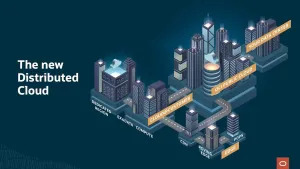
“The Cloud is undoubtedly great. It is elastic, flexible and scalable. It is also great because it is someone else’s job to manage the cloud infrastructure.” These were the opening lines of Chris Chelliah, Senior Vice President of Technology and Customer Strategy- Oracle Corporation JAPAC, from a recently held virtual press briefing.
However, with greatness come extraordinary challenges. Provided that clouds are scattered around a few far away and diverse locations, the migration process is significantly more complex and exhausting.

Some of the leading complications of cloud adoption that Chris highlighted include:
Data Residency: By nature, customers are hesitant to hand over their data, which may contain highly confidential and valuable material, to a third-party vendor. They mentally feel secure and comfortable if data remain on-premises or within the boundaries of their data centres.
Security and Privacy: This is perhaps the pivotal concern of cloud customers. Given the sophisticated nature of contemporary cyber attacks, relying on a third party for data security is always risky.
Latency and Performance: Industries like manufacturing find it profoundly disturbing to move to the cloud. They simply cannot push their factory lines to the cloud. In such cases, the cloud service must come to them.
Regulatory Concerns: Having your data at a site that does not entirely belong to you will naturally result in a lack of control and regulation. As a result, Businesses, particularly giant ones, are left with fewer options when it comes to the customisation of their storage setup.
Due to the aforementioned concerns, Chris said a considerable proportion of organisations are hesitant of moving to the cloud. “Even after 12-15 years of the cloud being used as the common vernacular in the market, only 20 per cent of the customers’ [IT spend is] on the cloud, while the rest of the 80 per cent are still stuck on-premises,” said Chris.
However, there are alternatives available for organisations to avail of some of the cloud benefits but those options also involve numerous limitations. For example, they can use software like OpenStack that could bring the cloud to on-premises but it only ensures some benefits since the responsibility of building, managing and creating is solely on the service users. Likewise, through on-premises virtualisation, enterprises can enjoy some cloud offerings but the rest- buying, building, structuring, managing, and security- will be entirely their responsibility.
Considering the psychology of buyers, Chris highlighted some fundamental reality checks regarding customers who seek all the value that comes with the cloud but not at the cost of control and reliability of their own data. In other words, they desire to unlock all the cloud functionalities, such as backup, security, and data management, in their data centres with no compromises attached.
Oracle Taking a Different Approach:
Seizing the market opportunity, Oracle Corporation came up with the idea of Cloud@Customer in 2014 to address the concerns of organisations that are less willing to move to the cloud. “We designed our cloud so that customers do not have either on-premises or cloud choice,” said Chris. What he meant was that Oracle Cloud Infrastructure (OCI) solutions not only serve public cloud seekers but also the clients who want public cloud services within the physical boundaries of their organisation.

There are various tools that customers can use to avail the benefits provided by the Cloud@Customer portfolio:
Oracle Cloud Infrastructure (OCI) Public Cloud: Oracle Corporation can help customers shift their entire data centre to an Oracle-managed public cloud and get advantages like agility, scalability, and security.
Dedicated Region Cloud@Customer: This tool offers all OCI public cloud services at the doorsteps of customers’ data centres.
Exadata Cloud@Customer: Helpful when customers want to move only specific business-critical applications in database workloads to the Oracle cloud.
Roving Edge: Ruggedised devices that deliver cloud services in isolated or disconnected locations or operations, such as remote factory operations or submarine deployments. These edge devices help to speed up the workloads in faraway regions.
Wrapping up the session, Chris highlighted how Oracle’s Cloud@Customer has been received with excitement by customers who now can access the cloud anywhere and anytime. “Manufacturers can now move the cloud to their shop floor, finance professionals can move their cloud inside their firewalls, and utility managers can drive it to their data centres,” concluded Chris.

Regarding the question about the cybersecurity aspects incorporated in OCI, Chris responded that Oracle offers services like autonomous databases or autonomous Linux that constantly monitors for vulnerabilities, fixes, and automatically applies patches when necessary, making OCI tremendously a secure model. Fascinatingly, the same security apparatus is also offered inside customers’ firewalls, allowing them to physically secure their data centres. As far as OCI’s availability in the ASEAN market is concerned, Chin Ying Loong, Regional Managing Director (Oracle) for ASEAN and SAGE, stated that we are growing rapidly, and our unique approach will undoubtedly assist us in excelling in this part of the world.




